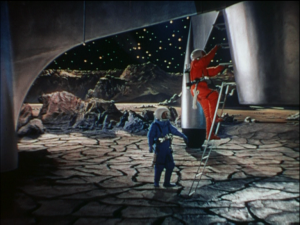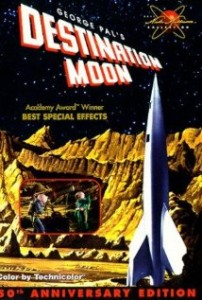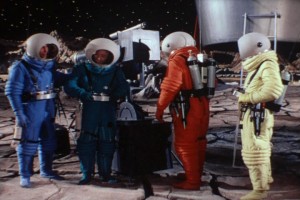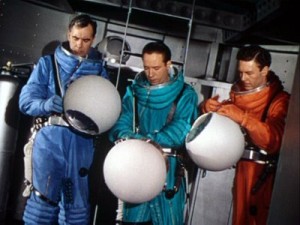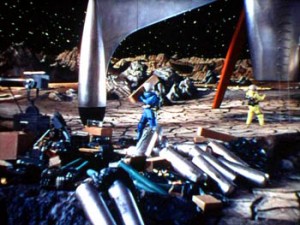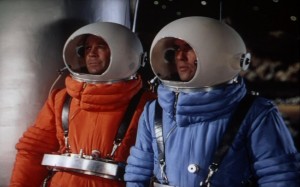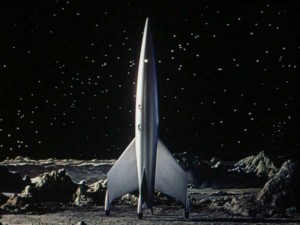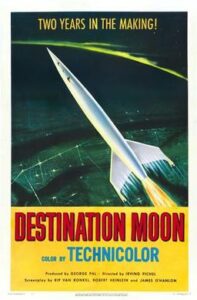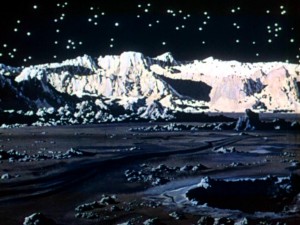Destination Moon **** (1950, John Archer, Warner Anderson, Tom Powers, Dick Wesson) – Classic Movie Review 490
George Pal’s pioneering Destination Moon (1950) is renowned as one of the first sci-fi films to go for as high level of accurate technical detail as possible at the time.
Visionary producer George Pal commendably attempts a realist approach in director Irving Pichel’s 1950 trailblazing sci-fi movie about a pioneering American moonshot in an atomic rocket in which four US astronauts have problems getting home. It’s renowned as one of the first sci-fi films to go for as high level of accurate technical detail as possible at the time.
Endless cost, energy, imagination, know-how, care and time were spent to make sets and gadgets look right; 100 men worked for two months just to build the moonscape alone. After a protracted start in which there is some anti-communist philosophising about reds under the beds and the pro-capitalist idea for the need for private-industry enterprise to spearhead the world’s first moonshot (by the Americans, of course) and the construction of the rocket, a gang of four astronauts finally rockets to the moon.
And thus, half way into the movie, a rather thin fragment of a plot actually begins. It is based on Robert A Heinlein’s 1947 novel Rocketship Galileo, adapted for the screen here by Heinlein himself, along with Alford Van Ronkel [Rip Van Ronkel] and James O’Hanlon. Heinlein also wrote the novels for Red Planet and Starship Troopers.
It turns out that there are no monsters on the moon, alas. But instead danger comes through a rather over-familiar antique plot device (seemingly borrowed from old submarine movies) as it emerges about how the guys are gonna get home with too much weight and too little fuel.
Tom Powers stars as retired General Thayer, who approaches Jim Barnes (John Archer), the head of his aviation construction firm to help build a rocket that will take him and Dr Charles Cargraves (Warner Anderson) into space so that the US can be the first nation to put a man on the moon. They build their rocket and make the landing but Barnes has somehow miscalculated fuel consumption so they can’t all get home.
After stripping the ship, they are still 100lb overweight, so one man must draw the short straw and stay on the moon. Dick Wesson also stars in his debut as Joe Sweeney and Erin O’Brien-Moore plays Emily Cargraves.
This key sci-fi movie spearheaded the vogue for these movies in the 50s and is important historically. It predated space flights and predicts many of the details of actual events and there couldn’t have been 2001: A Space Odyssey or Star Wars without it.
The special effects won the 1951 Academy Award for Best Special Effects in the name of the effects director, Lee Zavitz. Of course their effect and impact have greatly faded but they are still charming and attractive. It’s a shame that the most rudimentary thing about the movie is the acting. But cinematographer Lionel Lindon’s Technicolor filming is a huge plus and so is Leith Stevens’s Golden Globe nominated score with its atmospheric themes and musical motifs.
The production designs by Ernst Fegté and George Sawley, who were Oscar nominated for Best Art Direction-Set Decoration, Color, are the keys to the lovely-looking sets. Also an asset is the Woody Woodpecker cartoon, which years later NASA updated and used to explain real-life space travel to the public.
The view of the moon was a Chesley Bonestell painting 13ft long, mounted on wheels and rolled past a stationary camera. To make the stars look bright, 534 holes were made in the painting and lit from behind.
The rocket uses water, heated by a nuclear reactor, as reaction mass. This system, but with electrical heating, is occasionally used for small unmanned rockets for scientific research.
To make the space suits seem to be in a vacuum they were padded to look inflated, which made the actors so hot in the studio lights they could wear them for only a few minutes at a time.
It had a budget of $592,000. Pal convinced the independent Eagle-Lion Films to co-finance a two-picture deal, with him putting up half the money. The first film, The Great Rupert, about a Puppetoon-like dancing squirrel, starring Jimmy Durante, flopped but the second, Destination Moon, was a major hit.
Destination Moon was two years in production, and released on 27 June 1950 in the US, and so the pioneer became the second space adventure film of the post-World War Two era. Piggybacking on its publicity, Lippert Pictures quickly shot Rocketship X-M in 18 days on a $94,000 budget and it opened in cinemas 25 days earlier.
Irving Pichel was subpoenaed by the House Un-American Activities Committee in 1947 and blacklisted, despite having never been called to testify.
The cast are John Archer as Jim Barnes, Warner Anderson as Dr Charles Cargraves, Tom Powers as General Thayer, Dick Wesson as Joe Sweeney, Erin O’Brien-Moore as Emily Cargraves, Franklyn Farnum as Factory Worker, Everett Glass as Mr. La Porte, Knox Manning as Knox Manning, Kenner G. Kemp as businessman at meeting, Cosmo Sardo as Businessman at Meeting, Bert Stevens as Businessman at meeting, Mike Miller as Man, Ted Warde as Brown, Irving Pichel as Narrator of Woody Woodpecker cartoon and Grace Stafford as Woody Woodpecker (voice).
© Derek Winnert 2013 Classic Movie Review 490
Check out more reviews on http://derekwinnert.com/

